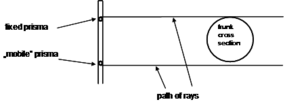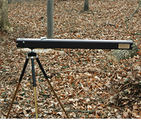Optical caliper
General description
The “Wheeler’s pentaprism” is an optical caliper that has two pentaprisms; a fixed one and a movable one. The construction allows generating parallel beams that correspondent to the arms of a mechanical caliper. (Figure 1). The sighting is situated at the position of the fixed prism and is separated into two parts. Through the upper part, the observer aims directly at the left hand side of the trunk (upper beam in Figure 1).

The second beam goes through the two prisms where the movable prism is moved back and forth in such a manner that the second beam aims at the right hand side of the stem. This is achieved by simultaneously looking through the lower part of the sighting where the picture of the trunk in the prism is mirrored to the left along the left side of the tree. For measuring the diameter, these two images must coincide. That means that the left side of the trunk in the direct and the indirect view is brought to a match. In that special case, the two parallel rays are tangent to the left and right hand side of the trunk and the diameter at the correspondent height can directly be read from the measuring bar.
One major drawback is that in addition to the diameter measurement, the height at the stem where diameter is measured must also be determined.
The principle of parallel beams holds for any distance from the tree, that is, this technique is theoretically independent of distance. However, the larger the distance the more difficult it is to aim at a particular tree in a particular height. Also, when light is bad in a stand, the usage of this device is extremely difficult.
References
- ↑ Kleinn, C. 2007. Lecture Notes for the Teaching Module Forest Inventory. Department of Forest Inventory and Remote Sensing. Faculty of Forest Science and Forest Ecology, Georg-August-Universität Göttingen. 164 S.

